龍泉寺の猫たちに会いに行く(愛知県名古屋市千種区姫池通 骨董買取いたします 古美術風光舎名古屋店)
2022.04.23
皆さまこんにちは
スタッフNでございます。
歩いてポイントをためるとドリンク1本無料になるコークオンアプリをご存知でしょうか?
Nは前からダウンロードしていたのですが、そんなに歩くこともなく自販機で買う時にポイントがつくくらいでした。
しかし、ここで働き始めてからポスティングで歩くので、ポイントがたまるのです。
そして先日ついに1本無料チケットをゲット致しました。
歩数計にもなるし、達成感もあり一石二鳥でございますね。
最近運動不足を感じる方は、是非お試しくださいませ。
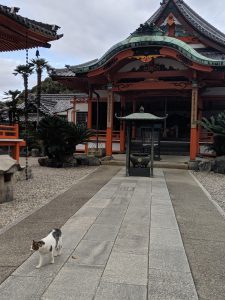
さて、名古屋市守山区の龍泉寺はご存知でしょうか?
スーパー銭湯竜泉寺の湯は有名ですよね。
その近くの龍泉寺、実は猫好きが集まる、猫スポットでもございます。
人懐こく触っても逃げない子もいらっしゃいます。
写真は数年前のものなので、今でも同じ猫がいるかはわかりません。
駐車場から境内までの林で、鳩を追いかけている猫様もおりました。
もしかたら、客人にごちそうしようと思ったのかもしれません。
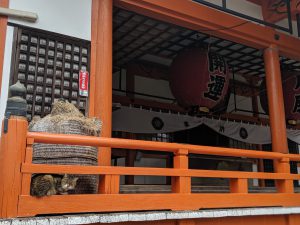
この龍泉寺、「竜泉寺」とも表記されるそうです。名古屋城を鎮護する尾張四観音のひとつで、尾張三十三観音霊場の第二十五番札所でございます。
「沙石集」によれば、尾張龍泉寺は龍王が一夜のうちに造立した寺で、馬頭観音が出た池の跡が見えるとされています。これを原型としたと思われる「龍泉寺記」(宝暦5年(1755年)記)には、延暦年間に伝教大師最澄が熱田神宮参籠中に龍神のお告げを受け、多々羅池畔で経文を唱えると、池から龍が昇天すると同時に馬頭観音が出現したので、これを本尊として祀ったのが開基とされております。
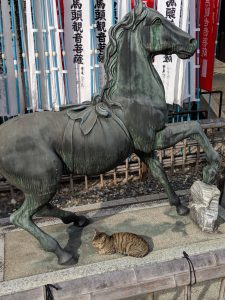
一方、弘法大師空海も、熱田神宮参籠中に熱田の八剣のうち三剣をこの龍泉寺に埋納したといわれ、これより龍泉寺は熱田の奥の院とされてまいりました。
龍泉寺は庄内川を望む高台にあり、庄内川、崖、湿地に囲まれた要害の地であって濃尾平野を一望できるため、古くから戦闘の際には軍事的価値を認められて陣を置かれることが多かったそうです。弘治2年(1556年)織田信行が城を築いたと言われ、永禄3年(1560年)の桶狭間の戦いの前には、清須城北東方面の防衛線を築くために織田信長が一隊を龍泉寺に派遣しています。天正12年(1584年)の小牧・長久手の戦いの際には、小幡城に進出した徳川家康を討つべく羽柴秀吉が陣を張っりましたが(このことが後に「一夜堀」の伝説を生んだ)、秀吉が退却するときに放火されて建物が焼失しました。慶長3年(1598年)に近辺の寺院密蔵院の僧侶秀純によって再興されましたが、明治39年(1906年)2月に再び放火され、多宝塔、仁王門、鐘楼を除く全てが焼失しました。その焼跡から、慶長大判切2枚、慶長小判98枚の入った小判容器が発掘され、これが基金となって本堂が再建されたというエピソードがございます。
多宝塔は明治28年(1895年)に建造されたものだそうです。
このように尾張の歴史上、龍泉寺は何度か軍事施設として使われたこともあり、「龍泉寺城」とされることもありました。現在でも境内の周囲の一部には空堀状の跡が残されているほか、境内裏側の日本庭園の横には三層の模擬天守が建てられています。これは、重要文化財の木造地蔵菩薩像や円空仏などを所有する宝物館を兼ねております。
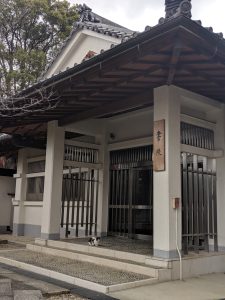
比叡山は古代より「大山咋神(おおやまくいのかみ)」が鎮座する神山として崇められていましたが、この山を本格的に開いたのは、伝教大師最澄(でんぎょうだいしさいちょう)上人(766~822)でありました。最澄は延暦7年(788年)、薬師如来を本尊とする一乗止観院(いちじょうしかんいん)(現在の総本堂・根本中堂)を創建して比叡山を開きました。
最澄が開創した比叡山は、日本の国を鎮め護る寺として朝廷から大きな期待をされ、桓武天皇時代の年号「延暦」を寺号に賜りました。
最澄は鎮護国家の為には、真の指導者である「菩薩僧(ぼさつそう)」を育成しなければならないとして、比叡山に篭もって修学修行に専念する12年間の教育制度を確立し、延暦寺から多くの高僧碩徳を輩出することになりました。特に鎌倉時代以降には、浄土念仏の法然上人、親鸞聖人、良忍上人、一遍上人、真盛上人、禅では臨済宗の栄西禅師、曹洞宗の道元禅師、法華経信仰の日蓮聖人など日本仏教各宗各派の祖師方を育みましたので、比叡山は日本仏教の母山と仰がれています。
比叡山延暦寺の最盛期には三千にも及ぶ寺院が甍を並べていたと伝えていますが、延暦寺が浅井・朝倉両軍をかくまったこと等が発端となり、元亀2年(1571)織田信長によって比叡山は全山焼き討ちされ、堂塔伽藍はことごとく灰燼に帰しました。
その後、豊臣秀吉や徳川家の外護や慈眼(じげん)大師天海大僧正(1536~1643)の尽力により、比叡山は再興されました。さらに明治初年の神仏分離や廃仏毀釈の苦難を乗り越えて現在に至っております。
庄内川中流域やその周辺の地域(春日井市・守山区・北区の一部)では、遠く平安の昔から天台の教えが栄え、その大きな影響は今日に及んでいます。この地方最大の天台本山であった密蔵院や、尾張四観音の一つである龍泉寺を始めとして多くの天台寺院がありました。現在区内にあるのは龍泉寺と石山寺のみで、廃れた寺には桂星寺(大森垣外 明治年間に廃寺)と白山寺(守山村 明治初年に廃寺)がありますが、それ以外にもかなりあったと考えられています。
鎌倉時代の僧、無住一円によって書かれた仏教説話集である沙石集によると、龍泉寺は密蔵院の末寺となる以前に、すでに観音信仰の霊場として知られていました。観音様には人々を病苦や災難から救う力があること、それが来世だけでなくて現世にも働くということが当時の人々に信じられていたからです。さらに、尾張龍泉寺は昔龍王が一夜のうちに造立した寺で、馬頭観音がでた池の跡が見えると書かれています。そしてその霊仏を信じて多くの人が集まり、毎月18日に観音経33巻を読んで供養していたということです。沙石集のこの記述は近世にまとめられた同寺の縁起の原型になったといえます。

龍泉寺には仁王門や出世地蔵尊像などの歴史的に重要な建造物や文化財を数多くあります。また、延宝4年(1676年)に龍泉寺を訪れ、彫像を遺したとされる円空の仏像も多数所蔵しており、その一部は龍泉寺城内の宝物館にてご覧いただけます。
龍泉寺何度か訪れてはおりますが、織田信長に関係あるとは知りませんでした。
そんな重要な建物の中で野良猫がのんびりしている様子を見ると、戦がなくなって平和になってよかったなあとしみじみ感じます。
ご興味があれば一度、龍泉寺へお参りに行かれてみてはいかがでしょうか?
ではでは
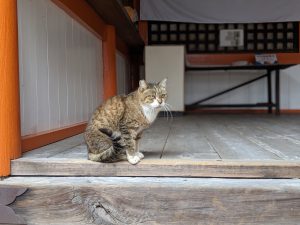
Hello everyone
This is Staff N.
Do you know the Coke on app where you can get one free drink by walking and collecting points?
I had downloaded N from before, but I didn’t have to walk so much and I got points when I bought it from a vending machine.
However, since I started working here and walked by posting, I can collect points.
And the other day I finally got one free ticket.
It can be used as a pedometer, and it has a sense of accomplishment, so it’s two birds with one stone.
If you feel lack of exercise recently, please try it.
By the way, do you know Ryusenji Temple in Moriyama Ward, Nagoya City?
Super public bath Ryusenji no Yu is famous, isn’t it?
The nearby Ryusenji Temple is actually a cat spot where cat lovers gather.
There are some children who can’t escape even if they touch it friendly.
The photo is from a few years ago, so I still don’t know if there is the same cat.
Some cats were chasing pigeons in the forest from the parking lot to the precincts.
Maybe I wanted to treat the guest.
It is said that this Ryusenji Temple is also referred to as “Ryusenji Temple”. It is one of the four Owari Kannon that protects Nagoya Castle, and is the 25th billhouse of the Owari 33 Kannon Sacred Ground.
According to “Saishishu”, Owari Ryusenji is a temple built by Ryuo overnight, and you can see the remains of the pond where Hayagriva came out. In “Ryusenji-ki” (Horeki 5 (1755)), which seems to be based on this, the missionary master Saicho received a dragon god’s announcement while visiting Atsuta Jingu during the Enryaku year, and at the shore of Tatara Pond. When the enryaku was chanted, the horse head Kannon appeared at the same time as the dragon ascended from the pond, so it is said that it was enshrined as the principal image.
On the other hand, Kobo Daishi Kukai is also said to have buried three of Atsuta’s eight swords in this Ryusenji temple while visiting Atsuta Jingu, and from this point on, Ryusenji has become the inner temple of Atsuta.
Ryusenji is located on a hill overlooking the Shonai River, and is a fortified area surrounded by the Shonai River, cliffs, and wetlands. It seems that it was often placed. It is said that Nobuyuki Oda built the castle in Koji 2 (1556), and before the Battle of Okehazama in Eiroku 3 (1560), Nobunaga Oda was the one to build a defense line in the northeastern direction of Kiyosu Castle. We are dispatching a corps to Ryusenji. During the Battle of Komaki and Nagakute in 1584, Hideyoshi Hashiba set up a camp to defeat Ieyasu Tokugawa, who had advanced to Obata Castle (this later became the legend of “Ichiyabori”. (Born), when Hideyoshi retreated, it was set on fire and the building was burned down. It was revived in the 3rd year of Keicho (1598) by a monk Hidezumi of a temple treasury in the vicinity, but it was set on fire again in February 1906, and everything except the Tahoto, the Niomon, and the bell tower was destroyed by fire. bottom. From the burn, there is an episode that an oval container containing two Keicho large-sized cuts and 98 Keicho oval-sized pieces was excavated, and this was used as a fund to rebuild the main hall.
The Tahoto is said to have been built in 1895.
In this way, in the history of Owari, Ryusenji was used as a military facility several times, and was sometimes called “Ryusenji Castle”. Even now, there are traces of an empty moat in a part of the surrounding area of the precincts, and a three-story simulated castle tower is built next to the Japanese garden on the back side of the precincts. This also serves as a treasure house that owns the wooden Jizo Bodhisattva statue and Enku Buddha, which are important cultural properties.
Since ancient times, Mt. Hiei has been worshiped as a mountain where “Oyamakui no Kami” is enshrined, but it was the Enryakuji Saicho that opened this mountain in earnest. It was a person (766-822). In the 7th year of Enryaku (788), Saicho founded Ichijo Shikanin (currently the main hall, Nemoto Nakado) with Yakushi Nyorai as the principal image and opened Mt. Hiei.
Mt. Hiei, which was founded by Saicho, was highly expected by the imperial court as a temple to protect and protect the country of Japan, and was given the year “Enryaku” of the Emperor Kanmu era as the temple name.
Saicho established a 12-year education system dedicated to training and training in Mt. Hiei, saying that for the guardian nation, it is necessary to train a true leader, “Bodhisattva”. , Many high priests Bodhisattva will be produced from Enryakuji Temple. Especially after the Kamakura era, Japanese Buddhism such as Honen Shonin, Shinobu Shonin, Ryonin Shonin, Ichigen Shonin, Mamori Shonin, Eisai Zen Master of the Rinsai sect, Domoto Zen Master of the Soto sect, and Nichiren saint of the Hokkekyo faith Since he raised the ancestors of each sect, Mt. Hiei is said to be the mother mountain of Japanese Buddhism.
It is said that as many as 3,000 temples were lined up during the heyday of Mt. Mt. Hiei was burned down all over, and all the temples and temples were returned to ash.
After that, Mt. Hiei was revived by the efforts of Hideyoshi Toyotomi, the guardian of the Tokugawa family, and the great priest of Enryakuji Tenkai (1536-1643). Furthermore, we have overcome the hardships of the separation of Shinto and Buddhism in the first year of the Meiji era and the abolition of Buddha.
In the middle reaches of the Shonai River and its surrounding areas (part of Kasugai City, Moriyama Ward, and Kita Ward), the teachings of Tendai have prospered since ancient times in Heian, and their great influence continues to this day. There were many Tendai temples, including the Mitsuzoin, which was the largest Tendai main mountain in this region, and Ryusenji, one of the four Owari Kannon. Currently, there are only Ryusenji and Ishiyamadera in the ward, and the abandoned temples include Keisei-ji (Omorigakigai, abandoned in the Meiji era) and Hakusanji (Moriyama-mura, abandoned in the first year of the Meiji era). It is believed that there were quite a few.
According to Shasekishu, a collection of Buddhist narratives written by the Kamakura period monk Muju Ichien, Ryusenji was already known as a sacred place for Kannon worship before it became the last temple of the Mitsuzoin. It was believed by the people at that time that Kannon had the power to save people from illness and disaster, and that it would work not only in the afterlife but also in this world. In addition, Owari Ryusenji is a temple that was built by the dragon king overnight, and it is written that you can see the remains of the pond where Hayagriva appeared. And many people gathered to believe in the spiritual Buddha and read the 33rd volume of Kannonkyo on the 18th of every month to make a memorial service. It can be said that this description of the Saishi collection became the prototype of the auspiciousness of the temple, which was compiled in the early modern period.
Ryusenji Temple is home to many historically important buildings and cultural properties such as the Niomon Gate and the statue of Ginza Shusseiji. In addition, he visited Ryusenji Temple in 1676, and has a large collection of Enku Buddha statues that are said to have left behind statues, some of which can be seen at the treasure hall inside Ryusenji Castle.
I have visited Ryusenji Temple several times, but I did not know that it was related to Oda Nobunaga.
When I see the stray cats relaxing in such an important building, I feel glad that the war has disappeared and it has become peaceful.
If you are interested, why don’t you visit Ryusenji Temple once?
See you soon
*********************
新年度を迎えました。
風光舎では、古美術品や骨董品の他にも絵画や宝石、趣味のお品など様々なジャンルのものを買受しております。
お片付けをされていて、こういうものでもいいのかしらと迷われているものでも、どうぞお気軽にご相談下さいませ。
また風光舎は、出張買取も強化しております。
ご近所はもちろん、愛知県内、岐阜県、三重県その他の県へも出張いたします。
まずは、お電話お待ちしております。
愛知県名古屋市千種区・骨董 買取
『古美術 風光舎 名古屋店』
TEL 052(734)8444
10:00-17:00 OPEN

